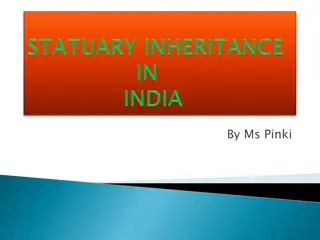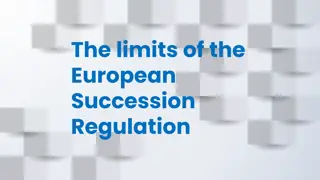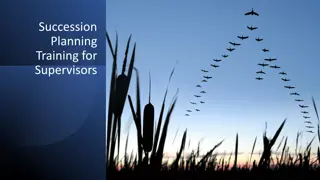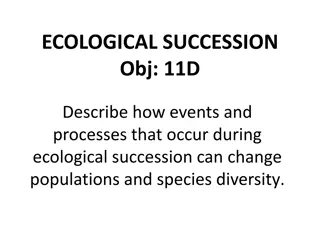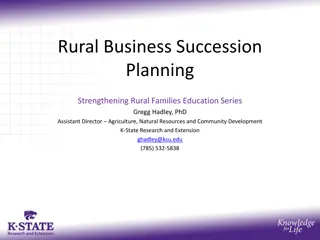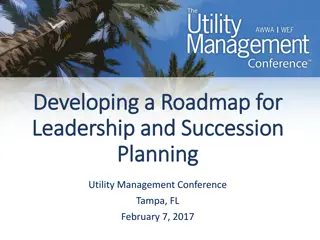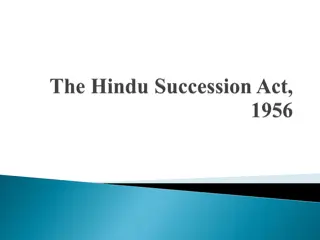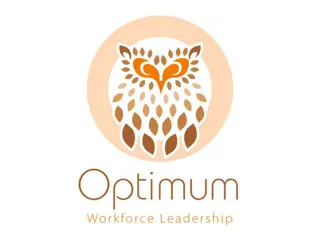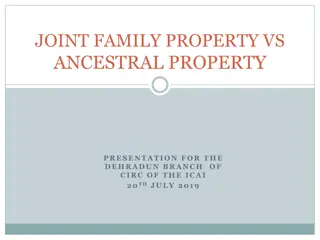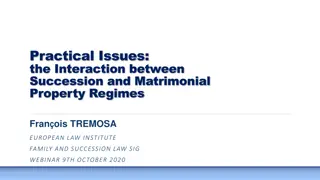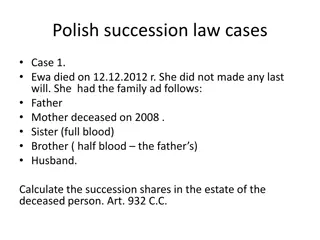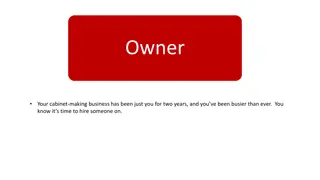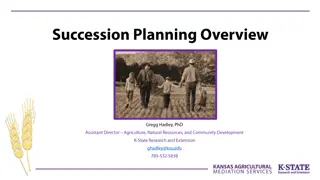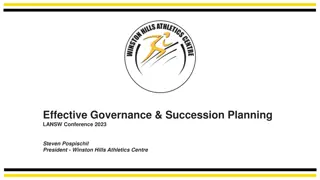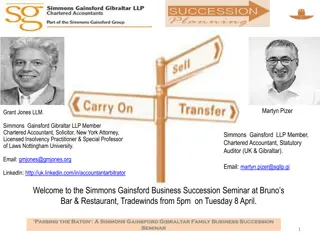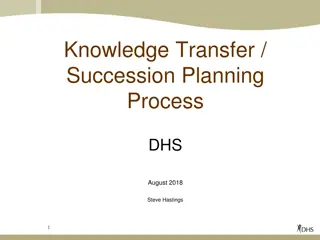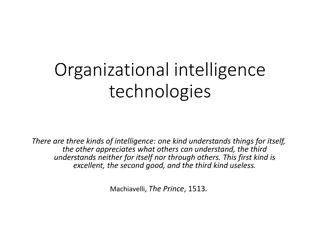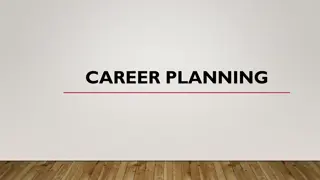Understanding Succession Planning in Organizational Development
Succession planning is crucial for organizations to ensure continuity in key staff positions. It involves preparing for unexpected departures and developing successors to fill in seamlessly. Despite its importance, organizations often avoid or postpone succession planning due to various reasons. The concept of succession development emphasizes the proactive preparation of successors to support the organization effectively in both short and long terms.
- Succession Planning
- Organizational Development
- Successor Development
- Staff Continuity
- Leadership Transition
Uploaded on Sep 10, 2024 | 0 Views
Download Presentation

Please find below an Image/Link to download the presentation.
The content on the website is provided AS IS for your information and personal use only. It may not be sold, licensed, or shared on other websites without obtaining consent from the author. Download presentation by click this link. If you encounter any issues during the download, it is possible that the publisher has removed the file from their server.
E N D
Presentation Transcript
Independent Living Research Utilization Independent Living Research Utilization 0
IL Conversation: IL Conversation: Succeeding at Succession Planning Succeeding at Succession Planning Paula McElwee Robert Hand 1
What is succession planning? What is succession planning? Succession planning is planning around who can do the job of key staff in the event that the current person is no longer available. Succession planning is both short and long term. While we most often think about the Executive Director position, it may be just as important to plan for unexpected absence of the fiscal person or the program manager. 2
Why do centers avoid or postpone planning Why do centers avoid or postpone planning for succession? for succession? It is difficult to talk about, even when the person who is leaving helps to drive the process. This is often called the hit by a bus scenario what will we do if ????? is hit by a bus? Maybe we should call it the won the lottery scenario. If the staff person won the lottery and is taking a trip around the world before deciding if they will continue to work... It is okay if the plan isn t too public. Sometimes it would be awkward to announce this because it seems like the announcement of a long-term successor. Other reasons? 3
Some common reasons for leave... Some common reasons for leave... Illness of a family member Death of an immediate family member Wedding/honeymoon Personal illness requiring rigorous treatment Injury requiring intensive rehab Publisher s Clearinghouse just awarded the person $5,000 a week. Others? 4
What about Succession Development? What about Succession Development? This gets to the heart of what needs to happen within your organization. You need to develop the ability of each successor so that they are ready and able to support the organization by filling in for a time. If changing the name from Succession Planning to Succession Development helps you communicate and act more efficiently, change the name. 5
Look at both long Look at both long- - and short and short- -term term It is easier to think about what to do while someone is on vacation and not available. (Yes, they should be unavailable when on vacation!) Start there. You have to have payroll who will do it? You need financial statements for board review. Who knows how to do that? Clearly it is urgent that someone (it can be a contractor) can take care of these necessary things if your fiscal person is gone. Can you partner with another center to back each other up? If the ED is on vacation, what necessary things might need to be done? 6
Engage the current staff in development Engage the current staff in development Jim Skinner, former CEO of McDonald's Corp., was known to tell managers: "Give me the names of two people who could succeed you." It was just one way the CEO continued the culture of succession planning at McDonald's. 7
Build from your short term plan... Build from your short term plan... Look at each position in the organizational chart. In the short term (for 30 days), who can back up another person? What training or practice needs to happen for that to be possible? Everyone needs to be aware of this plan, including the board. It DOES NOT WORK for a board member to be the short term sub for any position. You may want the board president or executive committee to be available to advise regarding any matter the board will need to approve or know about. 8
Ask yourself Ask yourself -- -- Will your vacation planning work in the short term should the bus or lottery come into play? Tweak it until it will work, and put it in writing. Now you have a plan for the first 30 days. Re-examine your plan any time job duties or players change. Practice this plan during vacations to work out the bugs. 9
Questions or comments? Questions or comments? 10
Now step back and look at the big picture... Now step back and look at the big picture... If something happened to you, how will the staff and board react. Reality sometimes there is a board member who is between jobs and everyone thinks, sure, we can help him out. Reality sometimes staff members are already positioning themselves to be the next ED. One center I know of purposely chose an internal person who would not want the ED position. It is wise to have a policy that board members cannot apply for any position unless they first resign from the board. 11
Avoid the turmoil Avoid the turmoil it can really set you back! it can really set you back! You may have seen some of the raging battles over center control in neighboring centers, or in your own center s history. The greed of wanting the ED position has hurt many non-profits Board members do not make the best interim Executive Directors. Make a policy about resigning before applying BEFORE you need it. Define in writing how a search will be conducted. Make sure everyone on staff understands their role during a transition. 12
Know the requirements Know the requirements 51% of your decision-making staff must be people with disabilities. (This is in addition to 51% of the rest of the staff.) If you only have one or two management staff, you must hire someone with a disability. Does the board know and understand this? ILA must affirm that the selected ED candidate (whether interim or long-time) is qualified. The job description you created and submitted with your grant gives other requirements that you must meet. Review this from time to time to make sure it still fits. 13
Yes, the search process is part of the plan Yes, the search process is part of the plan Did you know that NCIL and APRIL (for members) and ILRU post job openings for top positions? The state Vocational Rehabilitation office is also a good place to post. Others? Include a criminal background check in the process, if you don t currently require one. Even if you think you know the person well, you should do due diligence. Include a specific description of the search process in your succession plan. The board will need it. (Hint: Paula has a board checklist for the hiring of an ED if that would be helpful.) 14
Have the board approve the plan. Have the board approve the plan. The executive director should present the succession plan for her/his position to the board for approval. If the board is not sure of elements, work it out before there is an emergency. If you think there will be controversy internally around the appointment of an interim ED, you can work it out in Executive Session and keep the plan under wraps . The plan should be clear that the hiring decision for both the interim and the successor ED is the decision of the board. You don t get to actually make the decision about your successor, even if you are grooming someone. 15
So why is this my job, anyway? So why is this my job, anyway? Think of it as your last gift to the organization you ve worked so hard with. The board is probably not going to prepare without your prodding. They may change the plan you offer, but the result is that there is still a plan. When the ED leaves voluntarily or involuntarily, no matter what the reason the board must be ready and able to act. The succession plan provides a tool to assist them in getting it right as they move forward. 16
Keep it simple and realistic Keep it simple and realistic If you have work or education criteria that are in the way , reconsider them. Typically in CILs the important requirement is personal life experience with disability. A degree in a specific area may or may not be useful. Don t promise or even imply that someone is your chosen successor. The CEO doesn t make that decision the board does. Remember and remind the board that an unknown applicant is not necessarily better than the one you know. Sometimes the internal applicant is too well known to be promoted. Interview internal and external candidates fairly. 17
Recap Recap elements of a succession plan elements of a succession plan Who will manage essential functions during a short term absence or the first thirty days of an unplanned absence. Training needed to assume these functions. Process for extending short-term interim or appointing someone as interim until successor is chosen. Search and hiring process including if agreed, a national search, background checks, etc. Plan for transition from the current leader to the next when the current leader is still available to train/support. 18
Questions? Questions? 19
Contact information: Contact information: Robert J. Hand, M.S. bhand@ricv.org Executive Director Resources for Independence Central Valley Office: 559-221-2330 Cell: 559-273-4288 Paula L. McElwee, MRA Technical Assistance Coordinator IL-NET and New Community Opportunities Center paulamcelwee-ilru@yahoo.com (559) 250-3082 (direct/mobile) 20
SILC SILC- -NET NET Attribution Attribution Support for development of this training was provided by the Department of Health and Human Services, Administration for Community Living under grant number 90TT0001-01-00. No official endorsement of the Department of Health and Human Services should be inferred. Permission is granted for duplication of any portion of this PowerPoint presentation, providing that the following credit is given to the project: Developed as part of the SILC-NET, a project of the IL-NET, an ILRU/NCIL/APRIL National Training and Technical Assistance Program. 21
CIL CIL- -NET NET Attribution Attribution Support for development of this training was provided by the Department of Health and Human Services, Administration for Community Living under grant number 90TT0001-01-00. No official endorsement of the Department of Health and Human Services should be inferred. Permission is granted for duplication of any portion of this PowerPoint presentation, providing that the following credit is given to the project: Developed as part of the CIL-NET, a project of the IL- NET, an ILRU/NCIL/APRIL National Training and Technical Assistance Program. 22
New Community Opportunities New Community Opportunities Attribution Attribution Support for development of this training was provided by the Department of Health and Human Services, Administration for Community Living under grant number 90RR5006-01-00. No official endorsement of the Department of Health and Human Services should be inferred. Permission is granted for duplication of any portion of this PowerPoint presentation, providing that the following credit is given to the project: Developed as part of the New Community Opportunities Center at ILRU. New Community Opportunities Center at ILRU Independent Living Research Utilization


